Now Reading: Northwest, Indo-Gangetic Plain Cities Show Resilience to Long-Range Aerosol Pollution
-
01
Northwest, Indo-Gangetic Plain Cities Show Resilience to Long-Range Aerosol Pollution
Northwest, Indo-Gangetic Plain Cities Show Resilience to Long-Range Aerosol Pollution

Speedy Summary
- A study of 141 Indian cities (2003-2020) using satellite aerosol data identified two phenomena: Urban Aerosol Pollution Islands and Urban Aerosol clean Islands.
- In some south/southeast Indian cities, aerosol levels were higher compared to surrounding areas (pollution islands). conversely, in northwest/northern Indo-Gangetic cities, levels were lower compared to surroundings (clean islands).
- Clean Island Phenomenon: Linked to urban wind stilling effect-where urban infrastructure creates atmospheric stagnation zones that partially block incoming pollution.
- Higher background pollution in northern regions slows pollutant transport from outside sources such as dust from the Thar Desert and biomass burning.
- seasonal variations affect these patterns. The clean island effect was most noticeable during pre-monsoon periods due to dry conditions and less cloud cover for data observation.
- Southern Indian cities lack a clean island effect as they are primary polluters without significant external aerosol transport sources.
- Findings challenge conventional assumptions about long-range transported pollutants constantly adding urban pollution.
Images attached with the article:
!80/ClimateMouseIsland_59435.jpg”>Image 2
Indian Opinion Analysis
This study sheds new light on regional differences in urban air pollution dynamics across India,highlighting how geography,meteorology,and human development shape localized environments.The concept of Urban Clean Islands challenges conventional notions that cities always accumulate more pollutants then their rural surroundings; instead, certain northern cities act as barriers or diversions for incoming aerosols due to microclimate alterations caused by infrastructure growth.
For policymakers, these findings underscore the importance of tailored approaches when addressing air quality issues. While southern towns may need stricter focus on controlling internal emissions,northern regions require strategies considering external factors like transported dust flow or wind stagnation effects.Importantly, pre-monsoon periods prove critical for analysis due to clear visibility of phenomena influencing air dynamics.
The study evokes broader implications about planning sustainable and climate-resilient urban spaces while emphasizing the necessity for continued research into evolving microclimates amidst growing urbanization.
Read more: [Source Link]
























